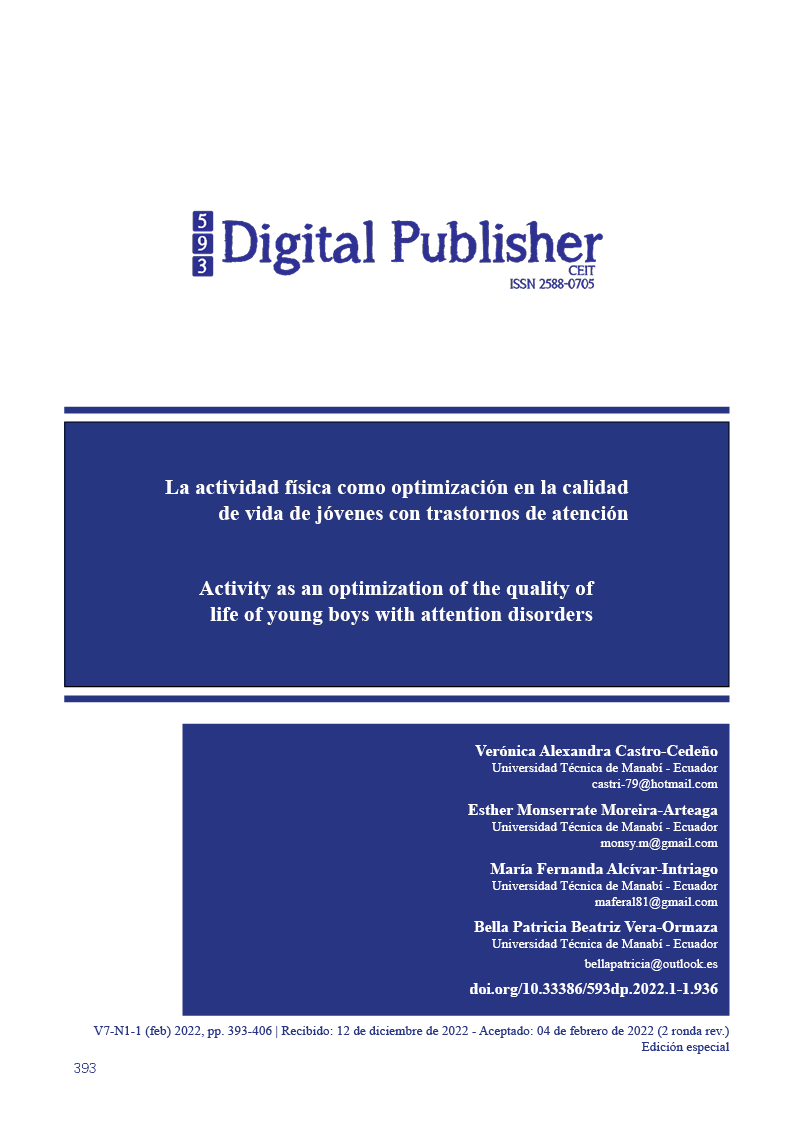La Activity as an optimization of the quality of life of young boys with attention disorders.
Main Article Content
Abstract
The Attention Deficit or Hyperactivity Disorder (ADHD) is the most frequent disorder of neurobiological origin, it is estimated that between 3% and 7% of the child-adolescent population suffer from it, in this research we inquire about the subject, whose general objective is: To determine the importance of physical activity as a means to improve the quality of life of people with Attention Deficit Hyperactivity Disorder (ADHD). The study is under a qualitative and quantitative approach. The research modality is Bibliographic-Documentary Research, and field research. The level of research is exploratory and descriptive. The population was made up of physical activity coaches and students with ADHD, the sample It was represented by five (5) coaches and ten (10) students. As a data collection technique, two (2) questionnaires were designed, one for coaches and the other for students. In the results, it was found that physical activity does improve the quality of life of students with this condition. In conclusion, it can be said that if students rely on physical activities, they will have a better performance both physically and mentally.
Downloads
Article Details

This work is licensed under a Creative Commons Attribution-NonCommercial-ShareAlike 4.0 International License.
1. Derechos de autor
Las obras que se publican en 593 Digital Publisher CEIT están sujetas a los siguientes términos:
1.1. 593 Digital Publisher CEIT, conserva los derechos patrimoniales (copyright) de las obras publicadas, favorece y permite la reutilización de las mismas bajo la licencia Licencia Creative Commons 4.0 de Reconocimiento-NoComercial-CompartirIgual 4.0, por lo cual se pueden copiar, usar, difundir, transmitir y exponer públicamente, siempre que:
1.1.a. Se cite la autoría y fuente original de su publicación (revista, editorial, URL).
1.1.b. No se usen para fines comerciales u onerosos.
1.1.c. Se mencione la existencia y especificaciones de esta licencia de uso.
References
Ara Royo, I., Vicente-Rodríguez, G., Moreno, L., Gutin, B., & Casajús Mallén, J. (2009). La obesidad infantil se puede reducir mejor mediante actividad física vigorosa que mediante restricción calórica. Apunts: Medicina de l’esport, 44, 111–118. https://raco.cat/index.php/Apunts/article/view/141316
Ardila, R. (2003). Calidad de vida: Una definición integradora. Revista Latinoamerica-na de Psicología, 35, 161–164.
Barrientos, E. (2010) Didáctica General. Recuperado de: https://isuuu.com/unmsm-prolex/docs/did__ctica_general
Bermuid,O.y Halperin, J.(2012)Emerging support for a role of exercise in attention-deficit/hyperactivity disorder intervention planning. Curr Psychiatry Rep (revista en linea), 14(5), 543-551.Disponible: http:www.ncbi.nlm.nih.gov/pmc/article/PMC3724411/pdf/nihms-01143.pdf con-sulta:2015, febrero 10
Calzada, J; Cachón, J; Lara, A; Zagalaz, M. (2016) (p233).http://www.journalshr.com/papers/Vol%208_N%203/V08_3_7.pdf.
Carriedo, A. (2014). Benefits of Physical Education in Children Diagnosed With Atten-tion Deficit Hyperactivity Disorder (Adhd). Journal of Sport and Health Research, 6(1), 47–60. http://www.journalshr.com/papers/Vol 6_N 1/V06_1_5.pdf
De la Osa JA. Hiperquinesia [Internet]. [citado 16 Ago 2016]. Disponible en: http://consultas.cuba.cu/consultas.php?id_cat=3&letr=h&id_cons=352&pagina=1
Díaz, J. (2019). Actividad física adaptada para personas con Lupus Eritematoso Siste-mático (LES): “La lucha entre la bella y la bestia”. Valencia, Venezuela. Aso-ciación Civil Editorial Predios.
Flohr, J., Saunder, M; Evans, S; (2014) Effects of physical activity on adademic perfor-mance and behavior in children with ADHD. Medicine&Science in Sport&exercise, 36 (5). S. 30-60.
Gómez G.Victoria L. (2017) Estado de nutrición y su relación con Condición Física en Adolescentes de escuelas preparatorias (tesis).Universidad Autónoma del Estado de México. Facultad de Medicina. Disponible en http://ri.uamex.mx/bitstream/handle/20.500.11799/68450/Tesis_LuisyGaby_LN.pdf?sequence=1&isAllowed=y
Hernández, Fernández y Baptista. Sexta Edición (2017). Metodología de la Investiga-ción, Versión final. MC Graw Hill. Educational. México
http://asp.salud.gob.sv/regulacion/default
http://consultas.cuba.cu/consultas.php?id_cat=3&letr=h&id_cons=352&pagina=1
La Organización Mundial de la Salud, (OMS). (2018). Consultada en: http://www.who.int/mediacentre/factsheets/fs385/es/
Ministerio de Salud El Salvador. Guías clínicas para la atención en salud mental y psi-quiatría. 2da ed. Salvador: Ministerio de Salud San Salvador; 2017. Disponible en:
Muñoz Suazo, D., Diaz Roman, A., Navarro Muñoz, J., Camacho Lazarraga, P., Robles Rodríguez, A., Ibáñez Alcayde, M., Coronilla, M., Gil García, E., Carballar Gonzá-lez, A., & Cano García, R. (2019). Mejora de la atención en niños y niñas con TDAH tras una intervención física deportiva dirigida. Cuadernos de Psicología Del Deporte, 19(3). https://doi.org/10.6018/cpd.360451
Neurodevelopmental Disorders. En: Pomeroy E. The clinical assessment Workbook balancing strengths and differential diagnosis [Internet]. 2da ed. Boston: CEN-GAGE Learning; 2015. p. 16-41. Disponible en: https://books.google.com.cu/books?id=TO4bCgAAQBAJ&pg=PA15&lpg=PA15&dq=American+Psychiatric+Association.+Diagnostic+and+statistical+manual+of+mental+dis or-ders.+5.+ed.+En:+American+Psychiatric+Association.+Neurodevelopmental+Disor ders;+2013.+p.59-66.&source=bl&ots=J1Wo-PGRdk&sig=oTBmks3ZieNScktuJt2QtbU8VlE&hl=es-
Suria, D. (2018). Desarrollo cognitivo de los individuos. Universidad de Alicante, Es-paña.
Valdivieso, F. (2011). En busca de una identidad perdida…: Apuntes para discutir una estructura del objeto de estudio disciplinar de la didáctica de la educación física. Maracay. Instituto Pedagógico “Rafael Alberto Escobar Lara”.





